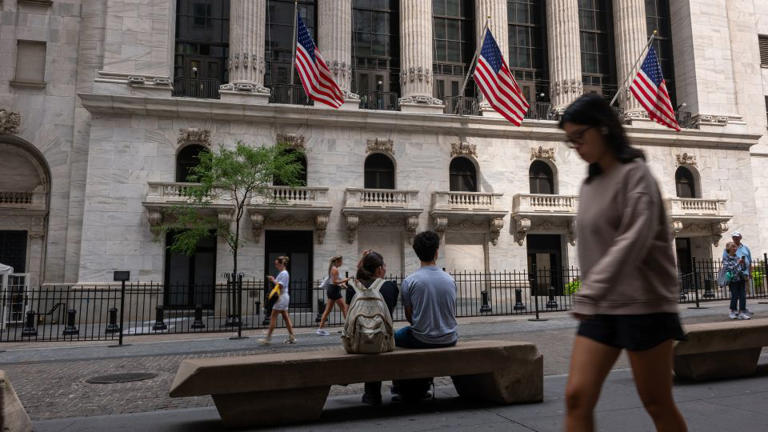In 2024, the stock market has achieved several record highs, propelled by robust corporate earnings, despite persistent inflationary pressures that have influenced investor expectations regarding Federal Reserve interest rate decisions. Recent economic data has sparked significant debate about the Fed’s next moves and has led to a notable shift in market dynamics.
Federal Reserve Interest Rate Cuts and Market Expectations
The strong performance of corporate earnings has driven U.S. stock indices to unprecedented levels this year. However, the persistent nature of inflation has tempered investor expectations about the timing and frequency of interest rate cuts by the Federal Reserve. Initially, there was a broad consensus that the Fed would begin reducing rates in September. However, recent data has prompted a reassessment of this timeline.
The Personal Consumption Expenditures (PCE) price index, which the Federal Reserve uses as its preferred gauge of inflation, showed a slowdown to 2.5% for the 12 months ending in June. This figure has been interpreted as a sign that inflation, which reached a four-decade high, is gradually easing. As a result, Wall Street has begun betting on a potential rate cut in September, driven by the hope that the Fed can achieve its dual mandate of controlling inflation while supporting economic growth.
On a recent Friday, the stock market demonstrated positive reactions to the cooling inflation data. The Dow Jones Industrial Average surged by 731 points, or 1.8%, while the S&P 500 and Nasdaq Composite gained 1.3% and 1.2%, respectively. These gains reflect growing investor optimism that the Fed may successfully manage inflation without derailing economic expansion—a feat it has managed only once since the 1990s. The economy’s robust 2.8% annualized growth rate in the second quarter, exceeding economists’ expectations, has further bolstered these hopes.
Bank of America’s Contrarian View
Despite the prevailing market sentiment, Bank of America (BofA) economists forecast that the Fed will delay its rate cuts until December. This view contrasts with the broader market expectation of an imminent cut in September. BofA’s stance is based on the premise that the Fed will wait for more comprehensive data before making a decision. The firm suggests that while recent inflation data shows some easing, the Fed may prefer to see sustained evidence of a cooling economy or further moderation in inflation before acting.
BofA’s economists emphasize that the Fed’s decision-making will be influenced by various economic indicators, including inflation and employment data. Although the Fed has projected just one rate cut for this year, market participants are betting on up to three cuts, according to the CME FedWatch Tool. BofA suggests that the Fed may choose to wait and let additional data inform its decisions, rather than reacting to market expectations prematurely.
Challenges for Big Tech Stocks
While generally positive market trends have been observed, recent performance in the tech sector has been mixed. The “Magnificent Seven” tech giants, which have significantly influenced market movements, faced substantial declines recently. Despite overall market gains, the S&P 500 and Nasdaq Composite saw their worst daily performances since 2022. This downturn was driven by underwhelming earnings results from key tech companies, including Tesla and Alphabet.
Tesla’s stock dropped 12.3% after reporting a significant decline in profits, while Alphabet’s shares fell 5% despite exceeding earnings expectations. The large weighting of tech stocks—32% of the total market capitalization as of late June—has amplified their impact on major indexes. The recent earnings reports from these tech giants have intensified the declines, highlighting the vulnerability of the market’s gains to setbacks within this sector.
Small-Cap Stocks and Market Rotation
In contrast to the challenges faced by big tech stocks, smaller-cap stocks have seen notable gains recently. Smaller companies typically suffer during periods of high interest rates due to their higher levels of floating rate debt. However, they often perform well when the Fed begins to ease monetary policy. The Russell 2000 index, which tracks small-cap stocks, has gained 10% so far this month, significantly outperforming the S&P 500’s modest gain of 0.2%.
This performance shift reflects a broader market rotation towards sectors and stocks that are expected to benefit from a lower interest rate environment. For example, homebuilder stocks have gained traction as investors anticipate that cooling inflation and potential rate cuts will ease the tight housing market. High interest rates had previously discouraged homeowners from selling their properties, driving up home prices to record levels.
Future Outlook and Investment Strategies
The debate over the timing of Federal Reserve rate cuts underscores the uncertainty surrounding economic forecasting. While big tech stocks face headwinds, the broader market is seeing a shift towards smaller stocks and other sectors poised to benefit from a more favorable interest rate environment. The performance of tech stocks and the Fed’s decisions regarding rate cuts will remain critical factors influencing market trends.
Investors are closely watching the Federal Reserve’s upcoming policy meeting for further indications of its approach to interest rates. As the economic landscape evolves, the market’s response to changes in monetary policy and corporate earnings will continue to shape investment strategies and market dynamics. The evolving situation highlights the need for investors to stay informed and adaptable as economic conditions and market expectations shift.
